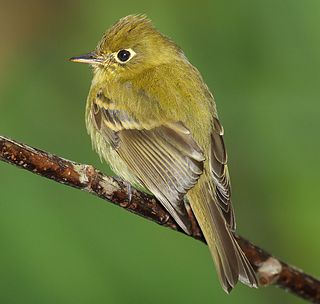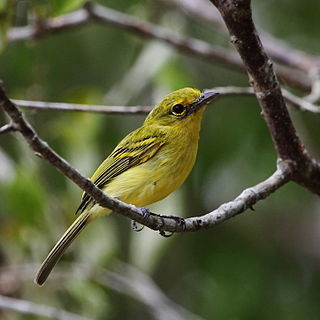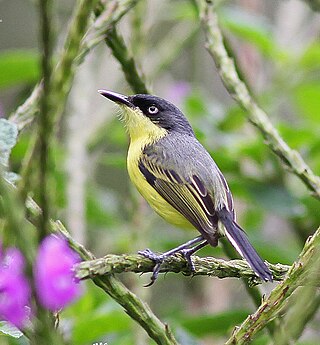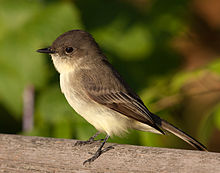
The tyrant flycatchers (Tyrannidae) are a family of passerine birds which occur throughout North and South America. They are the largest family of birds, with more than 400 species. They are the most diverse avian family in every country in the Americas, except for the United States and Canada. The members vary greatly in shape, patterns, size and colors. Some tyrant flycatchers may superficially resemble the Old World flycatchers, which they are named after but are not closely related to. They are members of suborder Tyranni (suboscines), which do not have the sophisticated vocal capabilities of most other songbirds.

The eastern phoebe is a small passerine bird. The genus name Sayornis is constructed from the specific part of Charles Lucien Bonaparte's name for Say's phoebe, Muscicapa saya, and Ancient Greek ornis, "bird". Phoebe is an alternative name for the Roman moon-goddess Diana, but it may also have been chosen to imitate the bird's call.

The great crested flycatcher is a large insect-eating bird of the tyrant flycatcher family. It is the most widespread member of the genus Myiarchus in North America, and is found over most of the eastern and mid-western portions of the continent. It dwells mostly in the treetops and rarely is found on the ground.

Say's phoebe is a passerine bird in the tyrant flycatcher family, Tyrannidae. A common bird across western North America, it prefers dry, desolate areas. It was named for Thomas Say, an American naturalist.

Tyrannus is a genus of small passerine birds in the tyrant flycatcher family Tyrannidae that are native to the Americas. The majority are named as kingbirds.

The ochre-lored flatbill or yellow-breasted flycatcher, is a passerine bird in the tyrant flycatcher family. It is found in South America, ranging from Colombia and Venezuela south to Peru, Bolivia, and Brazil, and on both Trinidad and Tobago. There are significant variations in its voice and plumage, with western birds duller and more olive, and eastern and northern birds brighter and more ochre-yellow. The two are sometimes considered separate species, the western olive-faced flatbill, T. viridiceps, and the eastern and northern ochre-lored flatbill, T. flaviventris.

The olive-faced flatbill or olive-faced flycatcher is a species of bird in the tyrant flycatcher family Tyrannidae. It is found in riparian woodland and at the forest edge in western Amazonia.

The vermilion flycatcher is a small passerine bird in the tyrant flycatcher family found throughout South America and southern North America. It is a striking exception among the generally drab Tyrannidae due to its vermilion-red coloration. The males have bright red crowns, chests, and underparts, with brownish wings and tails. Females lack the vivid red coloration and can be hard to identify—they may be confused for the Say's phoebe. The vermilion flycatcher's song is a pit pit pit pidddrrrreeedrr, which is variable and important in establishing a territory. Riparian habitats and semi-open environments are preferred. As aerial insectivores, they catch their prey while flying. Their several months-long molt begins in summer.

Pyrocephalus is a genus of bird in the tyrant flycatcher family, Tyrannidae.

The black phoebe is a passerine bird in the tyrant-flycatcher family. It breeds from southwest Oregon and California south through Central and South America. It occurs year-round throughout most of its range and migrates less than the other birds in its genus, though its northern populations are partially migratory. Six subspecies are commonly recognized, although two are occasionally combined as a separate species, the white-winged phoebe.

Myiozetetes is a small genus of passerine birds in the tyrant flycatcher family. The four species occur in tropical Central and South America.

The common tody-flycatcher or black-fronted tody-flycatcher is a very small passerine bird in the tyrant flycatcher family. It breeds from southern Mexico to northwestern Peru, eastern Bolivia and southern, eastern and northeast Brazil.

Myiarchus is a genus of birds in the tyrant flycatcher family Tyrannidae. Most species are fairly similar in appearance and are easier to separate by voice than by plumage.

The fork-tailed flycatcher is a passerine bird of the tyrant flycatcher family and is a member of a genus typically referred to as kingbirds. Named for the distinguishably long, forked tail, particularly in males, fork-tailed flycatchers are seen in shrubland, savanna, lightly forested and grassland areas, from southern Mexico to south past Argentina. They are most frequently observed sitting on conspicuous perches waiting for flying arthropods to fly past, they then sally out, eat their prey, and return to their perches. Northern populations near southern Mexico tend to be permanent residents, while fork-tailed flycatchers that live further south are migrants with a reputation for wandering to as far north as New Brunswick, Canada.

The ash-throated flycatcher is a passerine bird in the tyrant flycatcher family.

The tufted tit-tyrant is a species of bird in the tyrant flycatcher family Tyrannidae. This species is found in western South America; its range stretches from southern Colombia south along the Andes mountains to Tierra del Fuego. It prefers to live in upper montane forests and shrublands; however, it is a habitat generalist and can be found across a wide range of ecosystems. The tufted tit-tyrant has three subspecies, including the nominate subspecies Anairetes parulus parulus, A. p. aequatorialis, and A. p. patagonicus, and is very closely related to the Juan Fernández tit-tyrant. It is very small with a distinctive and conspicuous crest. The bird's head is black overall with white supraloral and postocular stripes. Its dull grayish-brown back contrasts with its white throat and breast that are covered with black streaks and pale, unmarked yellow underbelly. There are few noticeable differences in plumage between the subspecies. It is a vocal flycatcher with a broad repertoire of songs.

The cattle tyrant is a species of bird in the tyrant-flycatcher family Tyrannidae. In Brazil, it is called suiriri-cavaleiro. It is the only member of the genus Machetornis. The relationships of this species and genus to other genera in the tyrant flycatchers are uncertain. It resembles Tyrannus flycatchers, but this may be the result of convergence. Three subspecies are recognised, the nominate race, M. r. flavigularis and M. r. obscurodorsalis, although the latter two may not be distinct from M. r. flavigularis. The genus name was given to the species by George Robert Gray and is derived from the Ancient Greek makhētēs for fighter and ornis for bird, a reference to its pugnacious behaviour and habit of dispossessing other species of their nests. The specific name comes from the Latin rixosus meaning quarrelsome, again referring to the behaviour and temperament of the species.

Myiodynastes is a genus of birds in the family Tyrannidae. Created by Charles Lucien Bonaparte in 1857, the genus contains five species which are collectively referred to as "sulphur-bellied flycatchers"; that name is also given to one of the individual species in the genus. The genus name Myiodynastes is a compound word composed from two Greek words: muia, meaning "fly" and dunastẽs, meaning "ruler".

The ochraceous-breasted flycatcher is a species of bird in the family Tyrannidae, the tyrant flycatchers. It is found in Bolivia and Peru.

The loggerhead kingbird is a species of sub-oscine passerine bird belonging to the family Tyrannidae, the tyrant flycatchers. This species is found in wooded habitats in the islands of the northern Caribbean, with records of vagrants from Florida.
























